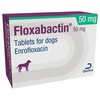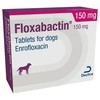Floxabactin
Floxabactin Tablets can be used to treat upper respiratory tract infections in cats, and to treat upper urinary tract infections (associated or not with prostatitis) and lower urinary tract infections caused by Escherichia coli or Proteus mirabilis in dogs. They can also be used for the treatment of superficial and deep pyoderma in dogs.
Floxabactin Tablets are presented as round, convex tablets that are white to slightly yellow in colour. They can be divided into 2 equal parts for easy and accurate dosing.
Floxabactin 50mg Tablets for Dogs
£1.60Floxabactin 50mg Tablets are indicated for the treatment of lower urinary tract infections (associated or not with prostatitis) and upper tract infections caused by Escherichia coli or...[More info]
Floxabactin 150mg Tablets for Dogs
£3.83Floxabactin 150mg Tablets are indicated for the treatment of lower urinary tract infections (associated or not with prostatitis) and upper tract infections caused by Escherichia coli or...[More info]
Floxabactin 15mg Tablets for Cats and Dogs
£0.80Floxabactin 15mg Tablets are indicated for the treatment of upper respiratory tract infections in cats, and of upper and lower urinary tract infections in dogs. Floxabactin can also be used...[More info]
Contraindications
Do not use in young or growing dogs (dogs aged less than 12 months (small breed) or less than 18 months (large breed) as the product may cause epiphyseal cartilage alterations in growing puppies).
Do not use in young, growing cats, because of the possibility of the development of cartilage lesions (cats aged less than 3 months or weighing less than 1kg).
Do not use in cats or dogs having seizure disorders, since enrofloxacin may cause CNS stimulation.
Do not use in cats or dogs with known hypersensitivity to fluoroquinolones or to any of the excipients of the product.
Do not use in case of resistance to quinolones, as there exists almost complete cross resistance to other quinolones and complete cross resistance to other fluoroquinolones.
Do not use with tetracyclines, phenicols or macrolides because of potential antagonistic effects.
Pregnant and lactating animals, please see Use during pregnancy and lactation.
Special precautions for use in animals
Retinotoxic effects, including blindness, can occur in cats when the recommended dose is exceeded.
It is prudent to reserve the fluoroquinolones for the treatment of clinical conditions that have responded poorly, or are expected to respond poorly, to other classes of antibiotics. Whenever possible, fluoroquinolones should only be used based on susceptibility testing. Official and local antimicrobial policies should be taken into account when the product is used. Use of the product deviating from the instructions given in this datasheet may increase the prevalence of bacteria resistant to fluoroquinolones and may decrease the effectiveness of treatment with other quinolones due to the potential cross resistance.
Use the product with caution in cats or dogs with severe renal or hepatic impairment.
Pyoderma is mostly secondary to an underlying disease. It is advisable to determine the underlying cause and to treat the animal accordingly.
Special precautions to be taken by the person administering the veterinary medicinal product to animals
People with a known hypersensitivity to (fluoro)quinolones should avoid any contact with the product. In case of accidental ingestion, seek medical advice immediately and show the package leaflet to the physician.
Wash hands after handling the product.
In case of contact with the eyes, rinse immediately with plenty of water.
Adverse reactions
- Hypersensitivity reactions
- Alterations in Central Nervous System
Cats:
Vomiting or diarrhoea may appear during the treatment. These signs regress spontaneously and generally do not require treatment discontinuation.
Dogs:
Possible joint cartilage alterations in growing puppies (see Contraindications).
In rare cases vomiting and anorexia are observed.
Use during pregnancy and lactation
Use during pregnancy:
Studies in laboratory animals (rat, chinchilla) have not produced any evidence of a teratogenic, foetotoxic, maternotoxic effect. Use only according to the benefit/risk assessment by the responsible veterinarian.
Use during lactation:
As enrofloxacin passes into the maternal milk, the use is not recommended during lactation.
Interactions
Concurrent use of flunixin should be under careful veterinary monitoring, as the interactions between these drugs may lead to adverse events related to delayed elimination.
Concomitant administration of theophylline requires careful monitoring as serum levels of theophylline may increase.
Concurrent use of magnesium or aluminium containing substances (such as antacids or sucralfate) may reduce absorption of enrofloxacin. These drugs should be administered two hours apart.
Do not administer simultaneously with tetracyclines, phenicols or macrolides because of potential antagonistic effects.
Do not administer simultaneously with non-steroidal anti-inflammatory drugs, convulsions can occur.
Amounts to be administered and administration route
Oral use
Dogs:
5 mg of enrofloxacin/kg/day as a single daily dosing, i.e. one tablet for 3 kg (Floxabactin 5 mg) / 10 kg (Floxabactin 50 mg) / 30 kg (Floxabactin 150 mg) daily for:
- 10 days in lower urinary tract infections
- 15 days in upper urinary tract infections and lower urinary tract infections associated with prostatitis
- Up to 21 days in superficial pyoderma depending on clinical response
- Up to 49 days in deep pyoderma depending on clinical response
Cats:
5 mg of enrofloxacin/kg body weight once daily for 5-10 consecutive days.
- Either 1 tablet for 3 kg body weight as a single daily dosing
- Or ½ tablet for 1.5 kg body weight as a single daily dosing
The treatment should be considered in case of lack of clinical improvement at half of the treatment duration.
The tablets may be administered directly in the mouth of the dog or cat or simultaneously with food if necessary.
Do not exceed the recommended treatment dose.
After breaking a tablet, use the remaining tablet half for the next dose. Store the tablet half in the original blister pocket.
Overdose
Overdosing can cause vomiting and nervous signs (muscle tremor, incoordination and convulsions) which may require treatment discontinuation.
In the absence of any known antidote, apply drug elimination methods and symptomatic treatment.
If necessary, administration of aluminium- or magnesium-containing antacids or activated carbon can be used to reduce absorption of enrofloxacin.
According to literature, signs of overdosage with enrofloxacin in dogs such as inappetence and gastrointestinal disturbance were observed at approximately 10 times the recommended dose when administered for two weeks. No signs of intolerance were observed in dogs administered 5 times the recommended dose for a month.
In laboratory studies, ocular adverse effects in cats have been observed from 20 mg/kg.
The toxic effects on the retina caused by overdosing may be such that they lead to irreversible blindness in the cat.
Pharmacological particulars
Pharmacotherapeutic group: Fluoroquinolone antibiotics
ATCvet code: QJ01MA90
Pharmacodynamic properties
Enrofloxacin is a synthetic fluoroquinolone antibiotic that exerts its activity by inhibiting topoisomerase II, an enzyme involved in the mechanism of bacterial replication.
Enrofloxacin exerts bactericidal activity concentration-dependent with similar values of minimal inhibit concentration and minimal bactericide concentrations. It also possesses activity against bacteria in the stationary phase by an alteration of the permeability of the outer membrane phospholipid cell wall.
In general, enrofloxacin exhibits good activity against most gram-negative bacteria, especially those of the Enterobacteriaceae. Escherichia coli, Enterobacter spp., Klebsiella spp. and Proteus spp. are generally susceptible.
Pseudomonas aeruginosa is variably susceptible and, when it is susceptible, usually has a higher MIC than other susceptible organisms.
Staphylococcus aureus and Staphylococcus intermedius usually are susceptible.
Streptococci, enterococci, anaerobic bacteria can generally be considered resistant.
Induction of resistance against quinolones can develop by mutations in the gyrase gene of bacteria and by changes in cell permeability towards quinolones.
Pharmacokinetic properties
Enrofloxacin is approximately 100% bioavailable after oral administration. It is unaffected by food. Enrofloxacin is rapidly metabolized to form an active compound, ciprofloxacin.
After a dose of 5 mg/kg body weight, maximum plasma levels of approximately 1.5 µg/ml in dogs and approximately 2.5 µg/mL in cats are reached after 0.5-2.0 hours.
Enrofloxacin is primarily excreted via the kidneys. A major portion of the parent drug and its metabolites is recovered in urine.
Enrofloxacin is widely distributed in the body. The tissue concentrations are often higher than the serum concentrations. Enrofloxacin crosses the blood-brain barrier. The degree of protein binding in serum is 14% in dogs and 8% in cats. The half-life lies between 3.0 and 6.8 hours for dogs and cats, respectively.
Approximately 25% of the dose of enrofloxacin is excreted in the urine and 75% via the faeces. Approximately 60% (dogs) or 15% (cats) of the dose is excreted as unchanged enrofloxacin in the urine and the remainder as metabolites, amongst others ciprofloxacin. The total clearance is approximately 9 ml/minute/kg body weight.


